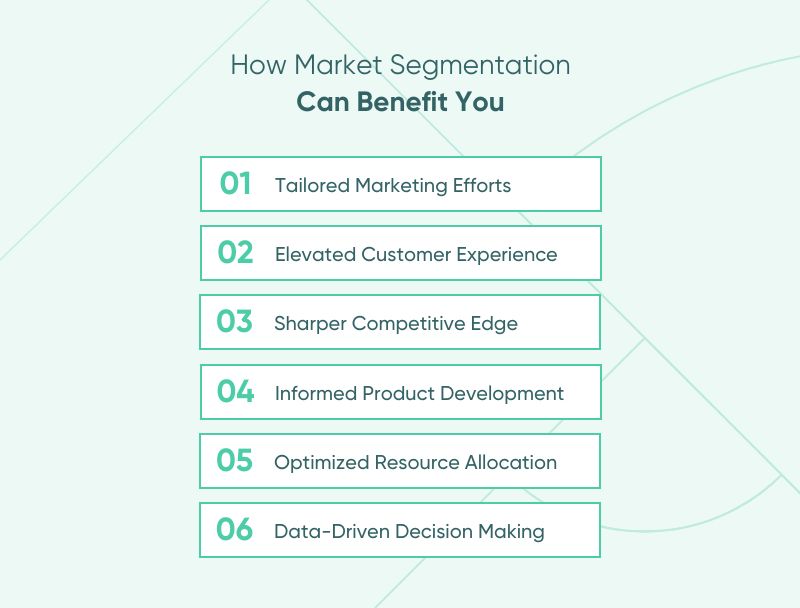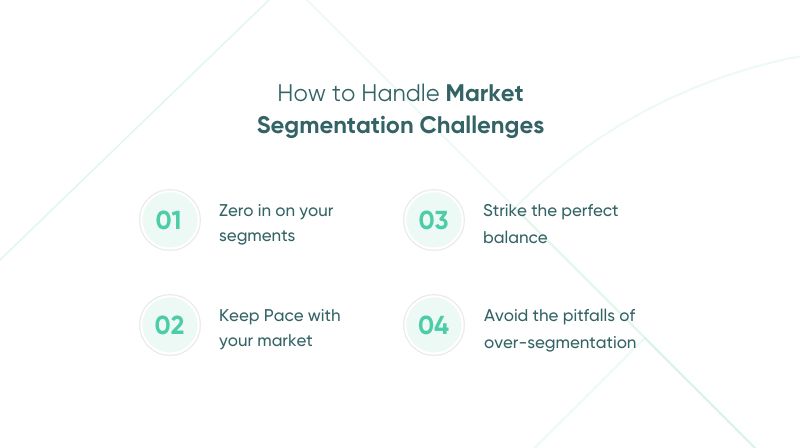Table of Contents
Navigating manufacturing isn’t just about keeping up with the latest technologies or production methods. It’s about understanding who you’re making these products for. Enter market segmentation: the strategy that slices the market into manageable, bite-sized pieces based on shared needs or characteristics.
Think of market segmentation as your GPS in the vast manufacturing landscape. It doesn’t just guide you; it ensures you’re heading in the right direction—towards more engagement, better satisfaction, and, ultimately, stronger sales.
Ready to dive deeper? Read on to learn more about mastering the art of market segmentation in manufacturing and how to craft marketing strategies that speak directly to each segment.
Harnessing the Benefits of Market Segmentation for Manufacturers

Market segmentation is more than a strategy; it’s a catalyst for growth and innovation in manufacturing. By focusing on manufacturing market segmentation, you’re not just selling products but creating solutions for distinct groups with specific challenges and desires. That’s how you stand out and connect with your audience.
Here’s how market segmentation revolutionizes the manufacturing industry:In the competitive manufacturing arena, understanding and applying market segmentation is akin to discovering a strategic blueprint for growth and customer engagement. It transforms generic outreach into a precision-targeted approach, delivering unparalleled benefits:
Tailored Marketing Efforts
By segmenting the market, you can craft highly personalized marketing campaigns. This specificity ensures messages resonate deeply with each audience, significantly improving the effectiveness of advertising efforts and boosting conversion rates.
Elevated Customer Experiences
Segmentation goes beyond marketing—it’s about understanding the heartbeat of each customer group. This insight allows manufacturers to exceed expectations, creating products and services that genuinely meet each segment’s nuanced demands, fostering loyalty and satisfaction.
Sharper Competitive Edge
Market segmentation offers clarity and stands out in a sea of competitors. By targeting distinct segments precisely, manufacturers can differentiate their offerings, making them the go-to choice for customers seeking solutions that address their specific needs and challenges.
Informed Product Development
The intelligence gathered from segmentation feeds directly into product innovation and development. This means products are not just made; they are sculpted with the insights and preferences of targeted segments, leading to higher demand, better customer feedback, and increased market share.
Optimized Resource Allocation
Effective segmentation ensures that every dollar spent on product development and marketing yields the highest possible return. As you focus your efforts on the most lucrative and responsive segments, you can allocate resources more efficiently, enhance overall ROI, and pave the way for sustainable growth.
Data-Driven Decision Making
Armed with detailed data about different market segments, you can make more informed decisions across all business areas. This data-driven approach helps anticipate market trends, changes in customer behavior, and potential new segments to target, ensuring your company remains agile and ahead of the curve.
By embracing the full spectrum of benefits offered by market segmentation, you can not only navigate the market’s complexities with greater ease but also carve out a path to innovation, customer satisfaction, and sustained success.
Tackling the Twists and Turns of Market Segmentation

Embarking on the market segmentation journey unlocks a world of possibilities, but it’s not without its twists and turns. While the potential rewards are vast, navigating the challenges is crucial for turning those possibilities into realities. Let’s delve into these challenges and how to overcome them, ensuring your segmentation strategy isn’t just a plan but a pathway to success.
Zeroing in on the Right Segments
It all starts with pinpointing the segments that truly matter. This is the bedrock of your strategy. But it’s not just about drawing lines around groups of customers; it’s about diving deep to understand which segments are distinguishable, reachable, and substantial enough to matter. It’s part science, part art, and entirely essential.
Keeping Pace with Changing Markets
If there’s one constant in the market, it’s change. Customers evolve, trends shift and needs transform. Staying relevant means your segmentation can’t be set in stone. It requires a nimble approach, ready to adapt and evolve. This continuous cycle of analysis and adjustment keeps your strategy fresh and focused.
Striking the Perfect Balance
The golden mean between broad appeal and niche targeting is elusive but attainable. Swing too broad, and your message loses its punch; too niche, and you might miss out on broader opportunities. The key is to find that sweet spot where your offerings resonate deeply without narrowing your potential market too much. It’s about being specific enough to be meaningful but flexible enough to scale.
Avoiding the Pitfall of Over-Segmentation
There’s a risk of slicing your market too finely in the quest to be all things to all people. Over-segmentation can spread your efforts thin, making it harder to make a significant impact in any one area. Remember, segmentation is a tool to concentrate your force, not dissipate it. It’s about finding the most effective way to allocate resources for the biggest impact.
In the vibrant and ever-changing world of manufacturing, leveraging market segmentation is the key to unlocking new levels of success. The journey is complex, but by facing these challenges head-on, you can craft strategies that resonate deeply with your target audience and propel your business forward with innovation and growth. It’s about balancing, staying agile, and always keeping the customer at the heart of everything you do. With a thoughtful approach to market segmentation, the opportunities are limitless.
Explorium.ai offers a powerful solution to the challenges of market segmentation through its advanced data enrichment and custom data signal capabilities, tailored to meet specific industry needs.
By leveraging Explorium’s tools, businesses can navigate the complexities of identifying and targeting vital segments. This allows for adaptation to market changes and achieving the right balance in segmentation strategies.
This approach enhances decision-making and ensures strategies resonate effectively with target audiences. Explore the potential of Explorium.ai to transform your segmentation efforts and learn more about their methodology in Data Enrichment – A Complete Introduction.
Crafting Your Blueprint: A Guide to Defining Market Segments
Embarking on the journey of market segmentation can feel like navigating a data labyrinth. But with a clear blueprint, you can uncover the segments that will supercharge your marketing strategies. Let’s dive into the segments you should consider and how to piece them together.
- Demographic Segmentation: Start with the basics—age, gender, income, occupation, and education level. These details might seem simple, but they’re goldmines for tailoring your marketing efforts.
- Geographic Segmentation: Where your customers are can tell you a lot about what they need. Geography shapes consumer needs and preferences, whether by country, region, city, or even climate.
- Psychographic Segmentation: Dive into your market’s psyche—values, interests, lifestyle data, and attitudes. This is where you get to the heart of what motivates your customers.
- Behavioral Segmentation: Look at how customers interact with your brand. Purchase history, product usage, and response to previous marketing efforts reveal patterns that help predict future behavior and preferences.
- Firmographic Segmentation: If you’re in B2B, firmographics are your bread and butter. Segment businesses by industry, size, revenue, or number of employees to tailor your approach to their unique organizational needs.
Here’s the kicker: combining these segments allows you to paint a detailed picture of your market. It’s not just about identifying who they are but understanding their world—what drives them, their challenges, and how your product or service fits into their narrative.
For those ready to dive deeper into the specifics of segmentation, particularly in the business realm, exploring firmographic segmentation can offer advanced insights and strategies. It’s your next step in mastering the art of market segmentation, enriching your marketing toolkit, and setting your strategies ablaze with precision and effectiveness.
Real-World Wins: Market Segmentation Success Stories
Welcome to the world of informed, data-driven marketing—where every message hits home, and every strategy is a step ahead. Diving into market segmentation theory is one thing, but seeing it in action? That’s where the magic happens.
Let’s uncover how some of the world’s most successful companies use market segmentation to stay ahead. These stories aren’t just inspiring—they’re a playbook for your segmentation success.
Nike’s Demographic Triumph
Nike knows one size does not fit all. By segmenting their market demographically, they’ve crafted specific product lines for different age groups, genders, and athletic needs. This approach lets them speak directly to each segment’s desires, driving loyalty and sky-high sales.
Starbucks’ Geographic Mastery
Starbucks turns geographic segmentation into an art form. It tailors its store layouts and menu offerings to fit local tastes and cultures, making every visit personalized. This strategy turns a global chain into a local favorite, proving the power of understanding your market’s geography.
Spotify’s Behavioral Personalization
Spotify uses behavioral segmentation to offer personalized music recommendations. By analyzing listening habits, it creates a custom experience for each user, making its service indispensable. Spotify’s strategy shows how understanding customer behavior can create an unbeatable value proposition.
HubSpot’s Firmographic Focus
In the B2B realm, HubSpot segments its market based on firmographics like company size and industry. This allows them to provide targeted content and solutions that resonate with each business’s specific challenges and goals, illustrating the power of fine-tuned B2B segmentation.
These examples illuminate the transformative power of market segmentation. By understanding and applying segmentation principles, these companies have not only honed their marketing strategies but also deepened their relationships with customers, fostering loyalty and driving growth. Let their success inspire you as you embark on your segmentation journey. With the right approach, the possibilities are limitless.
Charting the Path Forward: Ignite Your Market Segmentation Strategy with Explorium
As we’ve journeyed through the landscape of market segmentation for manufacturing businesses, it’s clear that this isn’t just a strategy—it’s a transformational tool. It carves out paths to deeper customer understanding, more resonant marketing messages, and innovative product development tailored to the unique needs of each segment.
Now, it’s your turn to harness the power of market segmentation. Whether you’re refining your approach or embarking on this journey for the first time, Explorium guides you every step of the way. With our cutting-edge platform, you can dive into the granular details of your market, uncover hidden segments, and unlock actionable insights that propel your business forward.
- Discover: Use Explorium to identify and analyze the segments that matter most to your manufacturing business.
- Strategize: Craft precision-targeted marketing strategies that resonate deeply with each customer group, leveraging Explorium’s data-driven insights.
- Innovate: Inform your product development with a deep understanding of customer needs, preferences, and behaviors, ensuring your offerings hit the mark every time.
The journey to market segmentation mastery begins with a single step. Take that step with Explorium and transform how you connect with your market. Visit our manufacturing guides to start reshaping your marketing strategy today. Let’s unlock the full potential of your manufacturing business together—segment, target, and conquer!
















